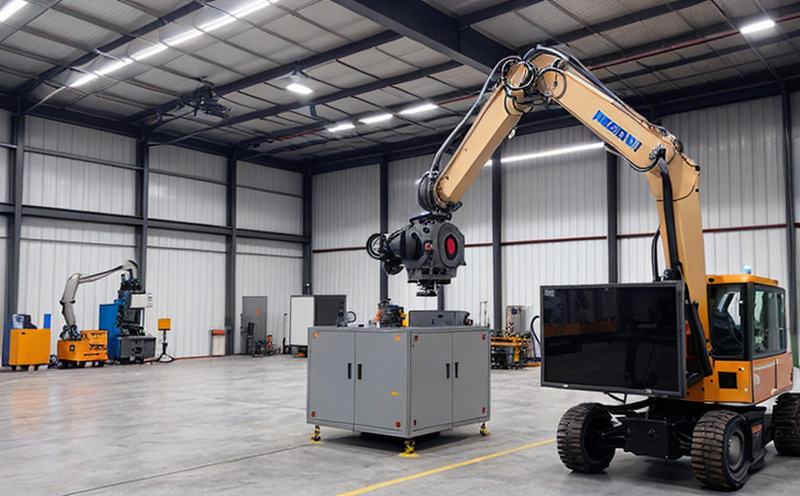ASTM F1459 Structural Integrity Testing of Robotic Arms
The ASTM F1459 standard is a critical benchmark for ensuring the structural integrity and safety of robotic arms used in industrial settings. This test evaluates the durability, load-bearing capacity, and resistance to stress and strain of robotic arms under various conditions. Compliance with this standard ensures that robotic systems meet the necessary quality benchmarks and are safe for use in demanding environments.
Robotic arms are integral components in manufacturing processes across a wide range of industries, including automotive, aerospace, electronics, and healthcare. The structural integrity of these arms is paramount to prevent accidents and ensure optimal performance. ASTM F1459 provides a standardized method to assess the structural properties of robotic arms, which helps manufacturers and quality assurance teams maintain consistent product quality.
The test involves subjecting the robotic arm to multiple stress cycles, evaluating its response under different loads, and measuring deformation and fatigue resistance. This comprehensive approach ensures that any potential weaknesses in design or manufacturing are identified early on, allowing for necessary adjustments before the robotic arm is deployed in operational environments.
For quality managers and compliance officers, ASTM F1459 testing offers a reliable means of verifying product safety and performance. R&D engineers can leverage this standard to innovate and refine robotic arms without compromising their structural integrity. Procurement teams also benefit from this test as it ensures that they are sourcing components and systems that meet the highest quality standards.
The ASTM F1459 testing process involves several critical steps, including specimen preparation, loading procedures, and data analysis. Specimens are typically robotic arms or arm sections that undergo cyclic loading to simulate real-world conditions. This can include static loads, dynamic loads, and combinations of both. The test setup includes specialized fixtures designed to apply these loads in controlled environments.
Upon completion of the test, detailed reports are generated, providing comprehensive data on the robotic arm's performance under stress. These reports are crucial for compliance officers and quality managers as they provide evidence of adherence to international standards. R&D engineers can use this information to refine designs and improve future iterations of robotic arms.
The ASTM F1459 standard is essential for ensuring that robotic systems meet the necessary safety requirements, which is critical in industries where precision and reliability are paramount. By adhering to this standard, manufacturers can enhance their reputation for producing high-quality products and gain a competitive edge in the market.
Scope and Methodology
| Test Parameters | Description |
|---|---|
| Cyclic Loading | Sustained application of static or dynamic loads to simulate real-world operating conditions. |
| Deformation Measurement | Continuous monitoring of deformation during and after loading cycles. |
| Fatigue Resistance Testing | Evaluation of the robotic arm's ability to withstand multiple stress cycles without failure. |
| Material Properties Analysis | Detailed examination of the materials used in the robotic arm, including tensile strength and yield point. |
| Acceptance Criteria | Details |
|---|---|
| Deformation Limit | No more than 10% deformation after cyclic loading. |
| Fatigue Life | The robotic arm must withstand at least 1,000 stress cycles without failure. |
| Material Integrity | Maintain minimum tensile strength and yield point as specified in the standard. |
Why Choose This Test
The ASTM F1459 structural integrity test is crucial for ensuring that robotic arms meet stringent safety and performance standards. By choosing this test, manufacturers can gain several key advantages:
- Enhanced Safety: Ensures that robotic arms are safe to operate in various industrial environments.
- Improved Reliability: Reduces the risk of accidents and downtime associated with mechanical failures.
- Compliance Assurance: Meets international standards, facilitating easier compliance for regulatory bodies.
- Innovation Support: Provides data that can be used to refine designs and improve future iterations of robotic systems.
- Quality Verification: Offers reliable evidence of product quality, which is essential for trust-building in the market.
The test results are highly valued by industry professionals as they provide a clear indication of a robotic arm's structural integrity. This information is invaluable for decision-making processes and can significantly impact business operations and reputation.
Customer Impact and Satisfaction
- Increased Safety: Reduced risk of accidents and injuries in industrial settings.
- Enhanced Reputation: Demonstrates a commitment to quality and safety, which can boost brand reputation.
- Better Decision-Making: Provides clear evidence of product performance, aiding informed procurement decisions.
- Improved Efficiency: Reliable robotic systems lead to increased productivity and reduced downtime.
- Regulatory Compliance: Ensures that products meet international standards, simplifying compliance processes.





